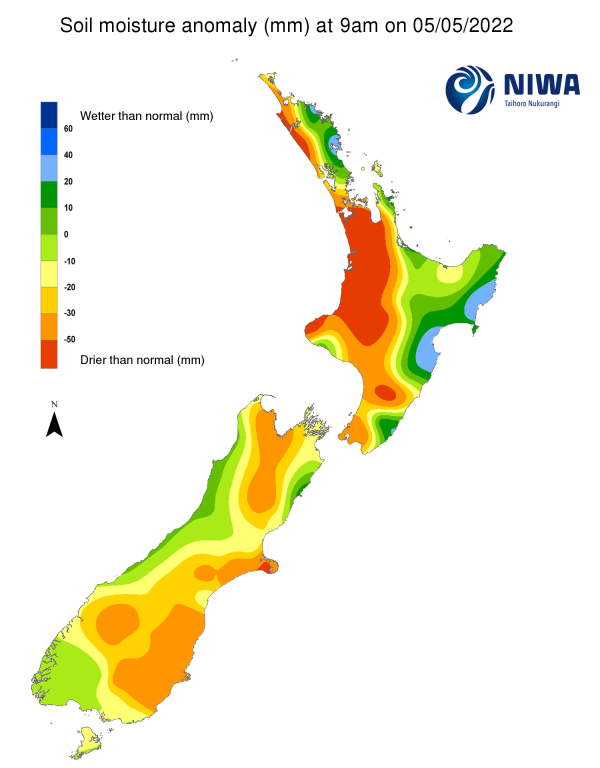A weekly update describing soil moisture patterns across the country to show where dry to extremely dry conditions are occurring or imminent. Regions experiencing significant soil moisture deficits are deemed “hotspots”. Persistent hotspot regions have the potential to develop into drought.
Facts: Soil Moisture
In the North Island, high pressure resulted in very dry conditions during the past week. Most locations observed 5 mm of rainfall or less, with many parts of the central and eastern North Island receiving no rainfall at all. However, parts of the Coromandel Peninsula received up to 50 mm. This resulted in moderate soil moisture decreases across nearly all of the North Island. The driest soils across the North Island, when compared to normal for this time of the year, are found in western Northland, southern Auckland, much of Waikato, and northern Taranaki, while the wettest soils for this time of the year are found in coastal Gisborne and Hawke’s Bay.
Hotspots are currently located in western Northland, parts of northern Waikato, and small pockets of Manawatū-Whanganui. As of 3 May, the New Zealand Drought Index (NZDI) map below shows that dry conditions are located in central Waikato.
In the South Island, heavy rain impacted much of the West Coast, with widespread amounts of 50-100 mm, and small pockets of 150 mm or more. However, meagre rainfall amounts of 5 mm or less were commonplace throughout the eastern South Island. This resulted in small to moderate soil moisture decreases for most areas, although little change was observed in the West Coast. The driest soils in the South Island, when compared to normal for this time of the year, are located in Banks Peninsula, while the wettest soils for this time of the year are found near Kaikōura.
South Island hotspots are currently located in coastal Selwyn and Ashburton districts, along with parts of southern Canterbury and interior Otago. As of 3 May, the New Zealand Drought Index (NZDI) map below shows that dry conditions are located in parts of the upper South Island, much of Otago, eastern Southland, and Stewart Island. In addition, very dry conditions are located in eastern Otago.
Outlook and Soil Moisture
In the North Island, high pressure will continue to bring dry weather through the upcoming weekend. On Monday (9 May), a front will move across the North Island with a period of light to moderate rain, with additional showers impacting the east coast on Tuesday. Thereafter, high pressure will return with generally dry weather. Weekly rainfall totals are expected to reach 15-25 mm in many locations, with pockets of 30+ mm possible in some coastal locations. However, rainfall totals are likely to be 15 mm or less in the upper North Island.
Due to the expected rainfall in the next week, soil moisture levels may not change significantly in most areas, although additional soil moisture decreases may occur in the upper North Island. This may result in strengthening and enlargement of the hotspots currently located in western Northland and Waikato.
In the South Island, a front may bring moderate to heavy rain to the West Coast from late Saturday through Sunday (7-8 May), with generally light rain east of the Alps. Many locations may see scattered showers on Monday and Tuesday (9-10 May), before high pressure returns for the rest of the week. Weekly rainfall totals may reach 50-100 mm in much of the West Coast, with up to 25 mm in the upper South Island. However, only 15 mm or less is expected in the lower South Island.
Due to the expected rainfall in the next week, soil moisture levels may improve slightly in the upper South Island and West Coast, while the lower South Island is likely to see soil moisture decreases. Existing hotspots in Canterbury and Otago may therefore strengthen and expand.
Background:
Hotspot Watch: a weekly advisory service for New Zealand media. It provides soil moisture and precipitation measurements around the country to help assess whether extremely dry conditions are imminent.
Soil moisture deficit: the amount of water needed to bring the soil moisture content back to field capacity, which is the maximum amount of water the soil can hold.
Soil moisture anomaly: the difference between the historical normal soil moisture deficit (or surplus) for a given time of year and actual soil moisture deficits.
Definitions: “Extremely” and “severely” dry soils are based on a combination of the current soil moisture status and the difference from normal soil moisture (see soil moisture maps at https://www.niwa.co.nz/climate/nz-drought-monitor/droughtindicatormaps)
Hotspot: A hotspot is declared if soils are "severely drier than normal" which occurs when Soil Moisture Deficit (SMD) is less than -110 mm AND the Soil Moisture Anomaly is less than -20 mm.
Pictured above: Soil Moisture Anomaly Maps, relative to this time of year. The maps show soil moisture anomaly for the past two weeks.
New Zealand Drought Index (NZDI)
As of 3 May, the New Zealand Drought Index (NZDI) map below shows that dry conditions are located in central Waikato, parts of the upper South Island, much of Otago, eastern Southland, and Stewart Island. In addition, very dry conditions are located in eastern Otago. Please note: some hotspots in the text above may not correspond with the NZDI map. This difference exists because the NZDI uses additional dryness indices, including one which integrates the rainfall deficit over the past 60 days. Changes are therefore slower to appear in the NZDI compared to soil moisture anomaly maps that are instantaneously updated.




